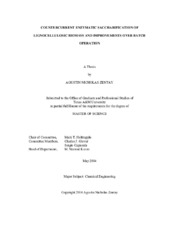| dc.description.abstract | Transportation fuels are the major driver for fossil fuel production, a burden that
many countries have tried to ease by blending fossil fuels with biofuel substitutes such
as ethanol. Current U.S. ethanol production relies on fermentation of starchy biomass
(e.g., corn), which competes with food. Using lignocellulose avoids competition with
food; however, it is difficult to digest using traditional batch saccharification. This work
investigates countercurrent saccharification as an alternative that reduces enzyme
requirements. Compared to baseline yields for standard batch saccharification,
countercurrent saccharification reduces enzyme requirements by 5 to 37 times.
Initial studies identified Solka-Floc as an acceptable substrate to represent treated
biomass; it is readily available and reliably consistent from sample to sample. To
measure yields, batch saccharifications were performed at various enzyme loadings and
reaction times. Two relatively low enzyme concentrations were selected for further
study: 2 and 5 mg protein/g biomass, or 2.6 and 6.4 mg protein/g glucan, respectively.
Both of the selected loadings are below levels suggested for commercial use.
For each enzyme loading tested, a multi-stage, semi-continuous countercurrent
train was constructed. The first experiments used trains consisting of eight 1-L bottles
loaded with α-cellulose, using the same concentrations as the batch experiments. Liquid
and solid phases were countercurrently contacted, with transfers of each phase occurring
every second day for approximately 4‒6 weeks, until steady-state operation was
maintained for at least 10 days. At 2 and 5 mg/g enzyme loadings, total sugar yields
reached 55.9% and 85.3%, respectively. A follow up study using 16 bottles and 2 mg/g loading produced total sugar yields of 73.4%.
In the interest of future scale-up, alternatives to the cycloheximide and tetracycline antibiotic cocktail were investigated. Preliminary results suggest that chloroform or a volatile essential plant oil may be effective. Future work is needed to confirm the antimicrobial strength of these compounds at low concentrations, which is needed to limit enzyme inhibition. | en |


